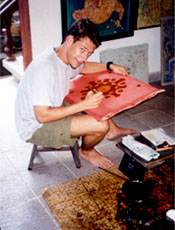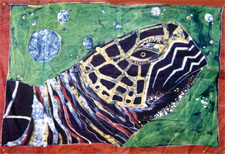Post from Tim:
We met Nyomen Suradnya while inquiring about batik classes. His easy going personality was about 50% pure Balinese and 50% well-traveled artist-hippie. Inside of his family compound and art gallery, his batiks and watercolor paintings hung side by side with plants and caged song birds. After brief introductions, the long-haired Indonesian offered us a drink and suggested we sit down, chill out, and take it easy. We chatted for a while and casually scheduled a class for a couple of days later.
 We arrived for our class in the morning, accepted an offer for thick Balinese coffee, and set to work. We were each given a white cotton cloth stretched across a wooden frame and a pencil to lay down a design. I sketched a geometric pattern, while Michelle drew a turtle.
We arrived for our class in the morning, accepted an offer for thick Balinese coffee, and set to work. We were each given a white cotton cloth stretched across a wooden frame and a pencil to lay down a design. I sketched a geometric pattern, while Michelle drew a turtle.
Batik is a process of waxing and dyeing cloth to produce unique patterns and designs. Indonesia is known for such cloth, as the variety of batiks offered for sale in every market here will testify. The process is simple: cover the fabric with bees wax to prevent dye from soaking in and dye the fabric. Like a screen print, the lightest color is used first and is covered by progressively darker colors.
The wax is applied with two tools, the chanting and the brush. The chanting works like a wax pen. One "draws" with the chanting's point as it pulls hot wax from a reservoir. Different size chantings draw dots and lines of varying sizes. The other tool, the brush, is used to cover large areas of fabric.
After a few fumbling attempts using the chanting on a practice cloth, I began outlining my sketch in wax. As each layer of wax seals in the current color, these outlines would remain on the finished piece as white. I worked for 30 minutes, and went on to the next step of dyeing the cloth yellow.
We continued through the layers of wax and colors. I next painted the area I wanted to remain yellow, and dyed orange. Then painted and dyed through red and blue.
I finished, yet had no idea what the piece looked like. It was a sloppy mess, covered in wax, hard, and dripping with dye. Delaying my need for instant gratification, I handed it over to Nyomen's assistants and planned to pick it up later.
 In my absence, his assistants fixed the dye with natural chemicals, boiled the cloth to remove the wax, and set the cloth out to dry. Nyomen was showing our finished pieces to a fellow Washingtonian traveler when we returned. She thought the pieces looked great, and much to my surprise, I did too.
In my absence, his assistants fixed the dye with natural chemicals, boiled the cloth to remove the wax, and set the cloth out to dry. Nyomen was showing our finished pieces to a fellow Washingtonian traveler when we returned. She thought the pieces looked great, and much to my surprise, I did too.
In case you are ever his way, you can reach him at (62 361) 975 415 or rodanet@denpasar.wasantara.net.id.
 We arrived for our class in the morning, accepted an offer for thick Balinese coffee, and set to work. We were each given a white cotton cloth stretched across a wooden frame and a pencil to lay down a design. I sketched a geometric pattern, while Michelle drew a turtle.
We arrived for our class in the morning, accepted an offer for thick Balinese coffee, and set to work. We were each given a white cotton cloth stretched across a wooden frame and a pencil to lay down a design. I sketched a geometric pattern, while Michelle drew a turtle. Batik is a process of waxing and dyeing cloth to produce unique patterns and designs. Indonesia is known for such cloth, as the variety of batiks offered for sale in every market here will testify. The process is simple: cover the fabric with bees wax to prevent dye from soaking in and dye the fabric. Like a screen print, the lightest color is used first and is covered by progressively darker colors.
The wax is applied with two tools, the chanting and the brush. The chanting works like a wax pen. One "draws" with the chanting's point as it pulls hot wax from a reservoir. Different size chantings draw dots and lines of varying sizes. The other tool, the brush, is used to cover large areas of fabric.
After a few fumbling attempts using the chanting on a practice cloth, I began outlining my sketch in wax. As each layer of wax seals in the current color, these outlines would remain on the finished piece as white. I worked for 30 minutes, and went on to the next step of dyeing the cloth yellow.
We continued through the layers of wax and colors. I next painted the area I wanted to remain yellow, and dyed orange. Then painted and dyed through red and blue.
I finished, yet had no idea what the piece looked like. It was a sloppy mess, covered in wax, hard, and dripping with dye. Delaying my need for instant gratification, I handed it over to Nyomen's assistants and planned to pick it up later.
 In my absence, his assistants fixed the dye with natural chemicals, boiled the cloth to remove the wax, and set the cloth out to dry. Nyomen was showing our finished pieces to a fellow Washingtonian traveler when we returned. She thought the pieces looked great, and much to my surprise, I did too.
In my absence, his assistants fixed the dye with natural chemicals, boiled the cloth to remove the wax, and set the cloth out to dry. Nyomen was showing our finished pieces to a fellow Washingtonian traveler when we returned. She thought the pieces looked great, and much to my surprise, I did too. In case you are ever his way, you can reach him at (62 361) 975 415 or rodanet@denpasar.wasantara.net.id.